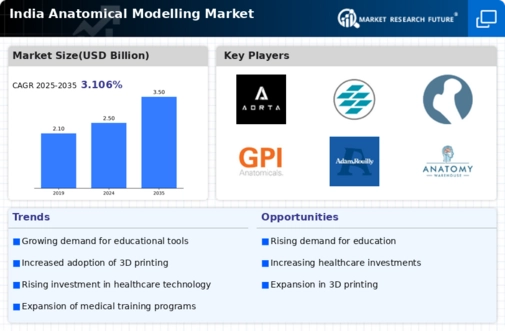Rising Demand for Surgical Simulations
The anatomical modelling market in India is experiencing a notable surge in demand for surgical simulations. This trend is driven by the increasing complexity of surgical procedures and the need for enhanced training tools. Medical professionals are increasingly utilizing anatomical models to practice and refine their skills before performing actual surgeries. The market for surgical simulations is projected to grow at a CAGR of approximately 15% over the next five years, indicating a robust expansion in the sector. This growth is likely to be fueled by advancements in technology and the rising emphasis on patient safety. As hospitals and medical institutions invest in high-quality anatomical models, the overall landscape of the anatomical modelling market is expected to evolve significantly, catering to the needs of both educators and practitioners.
Expansion of Medical Device Manufacturing
The anatomical modelling market in India is benefiting from the expansion of the medical device manufacturing sector. As the country positions itself as a hub for medical device production, there is an increasing need for high-quality anatomical models for product development and testing. Manufacturers are utilizing these models to ensure that their devices are designed with a thorough understanding of human anatomy. The medical device market in India is projected to grow at a CAGR of around 12% over the next few years, which will likely drive demand for anatomical models. This growth presents opportunities for collaboration between anatomical modelling companies and medical device manufacturers, fostering innovation and enhancing the overall quality of healthcare products. The synergy between these sectors is expected to bolster the anatomical modelling market significantly.
Growing Focus on Research and Development
The anatomical modelling market in India is significantly influenced by the growing focus on research and development (R&D) within the healthcare sector. Increased funding for biomedical research is leading to the creation of advanced anatomical models that facilitate innovative studies. Institutions and organizations are investing in R&D to develop models that accurately represent human anatomy, which is crucial for both educational and clinical applications. The R&D expenditure in the healthcare sector is projected to rise by approximately 10% annually, indicating a strong commitment to enhancing medical research capabilities. This trend is likely to drive the demand for sophisticated anatomical models, thereby propelling the growth of the anatomical modelling market. As researchers seek more precise and detailed models, the market is expected to adapt and expand accordingly.
Increased Awareness of Anatomical Education
There is a growing awareness of the importance of anatomical education in India, which is serving as a catalyst for the anatomical modelling market. Educational institutions are recognizing the need for comprehensive anatomical training to improve the competency of future healthcare professionals. This awareness is leading to increased investments in anatomical models for educational purposes, as they provide a tangible means for students to learn complex anatomical concepts. The market for educational anatomical models is expected to grow by approximately 18% in the coming years, reflecting the rising demand for effective teaching tools. As more institutions incorporate advanced anatomical models into their curricula, the anatomical modelling market is likely to experience a significant boost, aligning educational practices with the evolving needs of the healthcare industry.
Integration of Virtual Reality in Medical Training
The integration of virtual reality (VR) technology into medical training is emerging as a pivotal driver for the anatomical modelling market in India. VR offers immersive experiences that allow medical students and professionals to interact with 3D anatomical models in a virtual environment. This innovative approach enhances understanding and retention of complex anatomical structures. The market for VR in medical training is anticipated to witness substantial growth, with estimates suggesting an increase of around 20% annually. As educational institutions adopt VR technologies, the anatomical modelling market is likely to benefit from increased demand for high-fidelity models that can be used in conjunction with VR applications. This synergy between VR and anatomical modelling is expected to redefine medical education and training methodologies.




















Leave a Comment